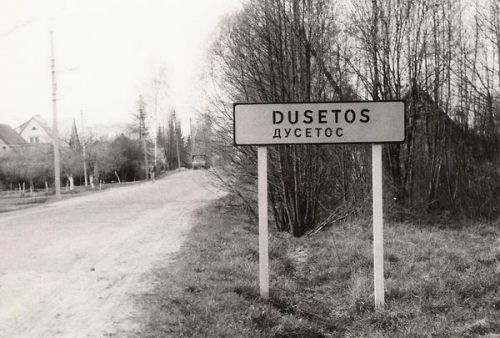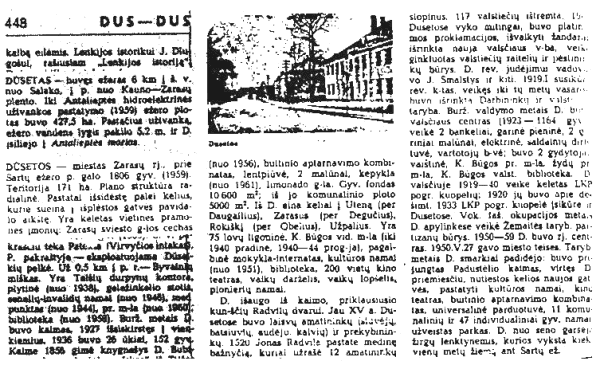
|
(Courtesy of Alex-Sasha Ozerman, May 1990)
|
[Pages 16-17]
|
|
| Dusetos, Vilnius Street [“Maskevitcher Gass”]
(Courtesy of Alex-Sasha Ozerman, May 1990) |
Dusiat is located on the banks of the River Sventoji near lakes Sartai, Sventoji and Dusetas, whence the name. Forests and pleasant scenery surround the shtetl. The neighboring towns include Antaliept (10 km.), Salok (26 km.), Ezerenai (36 km.), Utian (36 km.) and Rakishok (38 km.). Since the shtetl is situated at a distance from the railroad, connections with nearby towns are by road or dusty paths. There are three streets of wooden houses, at one end a Catholic Church whose tall towers overlook the entire shtetl.
Records of the shtetl date as far back as 1530. Already then, free artisans and merchants resided in the shtetl and there was an existing Jewish community. The land belonged to the Platter estate. In those days the shtetl was famous for being one of the strongholds of Polish resistance against the Russian regime.
In 1905 there were outbreaks of Czarist style pogroms in the shtetl (see Voskhod April 23, 1905 - Jewish newspaper in Russian). The Jewish-owned stores were looted and much property was destroyed. Torah books were desecrated and torn apart. A small group of Jews fortified themselves in one of the houses and threw stones at the rioters. One of the Jews, Yitzchak Barron, was brutally murdered while three others were badly injured.
That same year, and again in 1910, large fires broke out in the shtetl. In 1910 half of the Jewish homes and stores were burned down, along with the old synagogue.
The Jewish community: In 1847 there were 486 members of the Jewish community and by 1897 the numbers had risen to 1158 (89% of the population). After the fire of 1910, the Jewish community diminished and by the time the shtetl was restored in 1912, there were only 704 Jews left, about 250 families (70%).
The thirty stores in the shtetl all belonged to Jews. A number of Jews worked as farmers on leased land. The remainder were merchants, peddlers and artisans. The bulk of trading was with Dvinsk (via Ezerenai).
Market day was Wednesday, in addition to which there were two annual fairs.
During World War I, Jews did not leave Dusiat, but later on many did move from the shtetl to larger towns. After the war (in 1921) there were only approximately one hundred Jewish families in the shtetl, and by the eve of the Holocaust only eighty families remained.
The decline of the shtetl was both the result of being cut off from Dvinsk following the demarcation of new borders, and the anti-Semitic incitement by the local Verslininkai [members of the ultranationalist grouping Verslas, slogan “Lithuania for the Lithuanians”] who were against the “foreign” merchants and artisans. The Jews who remained in the shtetl made a living from peddling, trading and manual labor. There were thirty-two Jewish artisans in the shtetl (among them eight tailors, five butchers, five shoemakers, four smiths, two bakers and others). There were also a number of farmers, two flourmills, a power station and a candy factory owned by Jews. The Jewish Folksbank (National Bank) was founded in November 1924.
Owing to the difficult economic conditions, many Jews were forced to immigrate to Southern Africa, the United States, and even to Eretz Yisrael.
Before WWI, there were five to six Cheders and one Cheder Metukan (progressive) in Dusiat. During Lithuanian independence, there was a Tarbut (culture) elementary school whose principal was Hillel Schwartz and teachers were Yehuda Slep and Leib Gordon. There were 65 students in the school, ten children in the Cheder. Hebrew evening classes were held in the school, there was a library and a drama class. The branch of Hashomer Hatzair had eighty members while the Maccabi association numbered fifty. There was also a society for Torah studies, and Linat Hazedek and Gemach charity groups.
Among the rabbis in the shtetl was Rabbi Menachem Mendel from Lublin who taught Torah in the Zamut communities, Dusiat and Ponevez. He wrote the book Tamim Yachdav. Rabbi Nathan-Neta and his son Rabbi Bunim-Tzemach Silver were both born in Dusiat. The last Rabbi was Rabbi Tuvia-Dov Schlesinger (הי”ד[2]). The writer and poet Mordechai Yoffe, and Dov Garber, who conducted the choir in the synagogue of Dusiat and then in the Choral Synagogue of Kovno, were both born in Dusiat.
| Dusetai[3] – Shtetl in the province of Kovno. In 1847 there were 486 members of the Jewish community in Dusiat. In 1897 there were 1278 residents; among them 1158 Jews. In Easter of 1905, local peasants instigated a pogrom against the Jews, several of whom were killed. See Voskhod 1905, handbooks 16 and 17. |
 |
Mordechai Yoffe:
“The name of the shtetl in Russian is Dusetai; the Lithuanians call it Dusetos; and the Jews, as is typical of Litvaks, Dusat-Dushat; but for me it will always be D u s i a t.” [4]
Town located in the district of Zarasai, on the banks of the Sartai River, with 1,806 residents in the year 1959. It spans an area of over 171 hectares. The plan is radial. The buildings are located along the roads that meet at the central square. There are several local factories: butter producers association (since 1956), shoe factory, sawmill, two flourmills, bakery (since 1961) and lemonade industry.The entry Dusetos in the Small Lithuanian Encyclopaedia[5] covers the history of the shtetl from the time of its establishment in the 15th century up until 1959. However, the sole mention of the existence and destruction of the Jewish community is in the three words “Jewish elementary school”.
Roads from Dusetos lead to Utena (via Daugailiai), to Zarasai (via Deguciai), to Rokiskis (via Obeliai) and to Uzpaliai.
The local hospital has seventy-five beds. There is a high school named after Bugos (until 1940 it was an elementary school and during 1940-1944 it served as a junior high school – pro-gymnasia). There is another school which provides extra help for students, and which also has a boarding school.
It has a cultural center (since 1951), library, cinema and theater auditorium with 200 seats, kindergarten, daycare center and Pioneer House [for children of the Communist youth movement].
Dusetos sprouted from the village belonging to the estates of Prince Radziwill. Already in the 15th century there were free artisans in Dusetos: tailors, shoemakers, weavers, blacksmiths and merchants.
In 1520 Prince Radziwill built a wooden church with twelve houses for artisans, adjoining grazing areas and gardens near the Shetchura [thicket], three lakes, two taverns and some additional property. In the 16th century, the school was built near the church where some fifteen to thirty children studied, mainly from the nobility. In 1823 the school in Dusetos had three functioning classes. Since 1848 the school has been run by the local authority.
In the 18th century, Dusetos and the estates became the property of the rich aristocratic Platter family. In 1806 the townlet was burned down.
In 1811 there were 145 wooden huts and 907 residents in the townlet, and by 1897 it had grown to 1278 residents.
On March 29, 1831, the Polish rebellion broke out, led by Platter. The rebellion was crushed that same year, and the townlet, along with the estate, was taken away from the Platters and the palace destroyed. The neighboring villagers also took part in the 1863 rebellion which was headed by Lukoshionas, Barzeda and others. The rebellion was suppressed and 117 peasants were exiled.
In 1905 there were demonstrations, and revolutionary manifestos were distributed. The gendarmes were driven out and a new regional council was elected. Armed peasants made up a troop of mounted and foot soldiers. Heading the revolutionary movement in the townlet were Smalstis and others.
In January 1919 a revolutionary council was formed which remained active until the summer of that year, when it elected a council of peasant farmers and workers. During the period of bourgeois rule, Dusetos served as a regional center. In 1923 there were 1,164 inhabitants in the townlet. Services included: two banks, steam-operated dairy, two steam-run mills, power station, candy industry, cooperative, two doctors, pharmacy, elementary school named after Bugos, Jewish elementary school [Ed. emphasis] and the Bugos public library.
Between 1919 and 1940 a number of groups belonging to the Lithuanian Communist Party were active in the region. In 1920 there were approximately ten such groups and in 1933 an additional new group was founded in Dusetos. During the German Fascist occupation, a Soviet partisan company [named after Zemayta, a female Lithuanian writer] operated in the area of Dusetos.
Between the years 1950-1959 Dusetos became a regional center and on May 27, 1950, the community was recognized as a town. During the Soviet period the town grew tremendously. The village Padustelis was annexed to it, as well as several suburbs. New roads were paved. Cultural centers, cinema, complex of vital services and supermarket were all erected. Eleven public buildings were constructed as well as forty-seven houses.
Dusetos is famous for the horse races held every year during the winter on the shores of Lake Sartai.
Footnotes

|

"Sole mention of the Jewish community ..." |
|
JewishGen, Inc. makes no representations regarding the accuracy of
the translation. The reader may wish to refer to the original material
for verification.
JewishGen is not responsible for inaccuracies or omissions in the original work and cannot rewrite or edit the text to correct inaccuracies and/or omissions.
Our mission is to produce a translation of the original work and we cannot verify the accuracy of statements or alter facts cited.
 Dusetos, Lithuania
Dusetos, Lithuania
 Yizkor Book Project
Yizkor Book Project
 JewishGen Home Page
JewishGen Home Page
Copyright © 1999-2024 by JewishGen, Inc.
Updated 4 Apr 2009 by LA